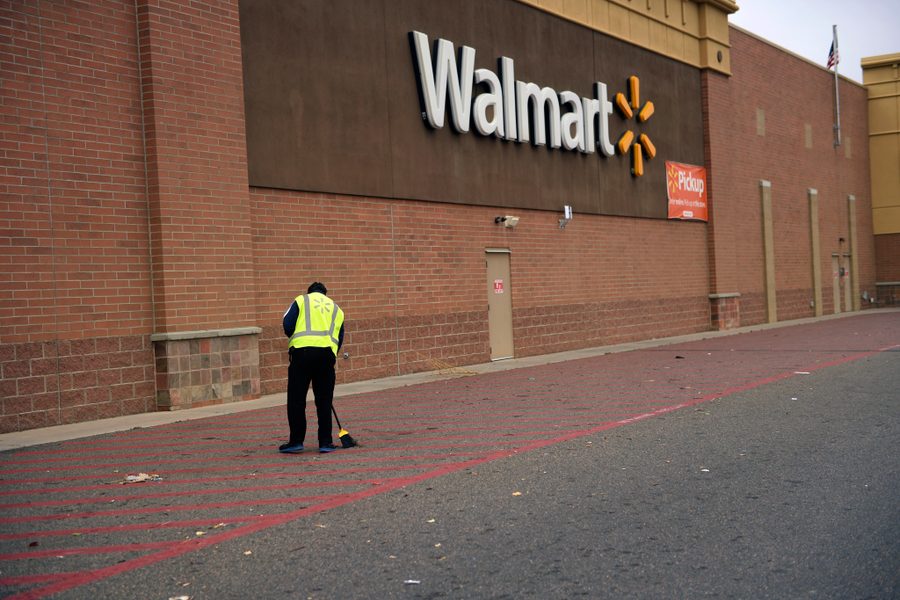Millions of U.S Workers for Walmart, McDonald’s and Other Corporate Giants Rely on Food Stamps and Medicaid
A new report commissioned by Bernie Sanders shows that corporations are soaking up profits—while paying workers so little they depend on government assistance to survive.
Jeff Schuhrke

Millions of full-time, adult workers in the United States — many of them employed by Walmart, McDonald’s and other highly profitable corporations — are paid wages so low they’re forced to rely on public assistance to make ends meet.
That is the key finding of a newly released report by the nonpartisan Government Accountability Office (GAO). Commissioned by Sen. Bernie Sanders (I-Vt.), the report analyzed data from 15 agencies administering Medicaid and the Supplemental Nutrition Assistance Program (SNAP, or “food stamps”) across 11 different states.
For all 15 agencies, Walmart was in the top four employers of Medicaid enrollees and SNAP beneficiaries, while McDonald’s was in the top five for 13 of the 15 agencies.
Other major retailers and fast-food companies were found to be among the most common employers of workers receiving Medicaid and SNAP, including Dollar Tree, Dollar General, Target, Amazon, Burger King, Wendy’s, Taco Bell, Home Depot, Lowe’s, Walgreens and CVS. Rideshare service Uber — which recently spent millions of dollars successfully defeating a California law that would have made its drivers eligible for basic worker protections and benefits — was also ranked among the top 15 employers of workers on public assistance.
“At a time when huge corporations like Walmart and McDonald’s are making billions in profits and giving their CEOs tens of millions of dollars a year, they’re relying on corporate welfare from the federal government by paying their workers starvation wages,” Sanders said of the report. “That is morally obscene.”
The new GAO report echoes the conclusions of similar studies by the University of California, Berkeley Labor Center in 2013 and 2015, which found that U.S. taxpayers are subsidizing large corporations to the tune of $153 billion per year in the form of public assistance programs to support their low-wage employees.
“It is time for the owners of Walmart, McDonald’s and other large corporations to get off of welfare and pay their workers a living wage,” Sanders added.
The federal minimum wage has been stuck at $7.25 an hour since 2009. While a majority of states have raised their respective minimum wages above the federal floor in the past decade, 21 states have not. Thanks to union-driven campaigns like the Fight for $15 and United for Respect (formerly OUR Walmart), eight states and multiple cities have enacted gradual increases to a $15-per-hour minimum wage in recent years. And on November 3, voters in Florida overwhelmingly approved a measure to raise their state’s hourly minimum wage to $15 by 2026.
Last July, the Democratic-led House of Representatives passed a bill to increase the federal minimum wage to $15 an hour, but the legislation went nowhere in the Republican-controlled Senate. President-elect Joe Biden supports a federal increase to $15, but whether or not such a bill can get to his desk in the near future likely depends on the outcome of Georgia’s January 5 runoff elections, which will decide which party gains control of the U.S. Senate.
In Georgia — where voters will soon determine the short-term fate of the $15 federal minimum wage — the official state minimum wage is a mere $5.15 an hour, with employers only required to pay $7.25 because of the federal legislation passed over a decade ago. According to the new GAO report, over 143,000 working adults in Georgia depend on SNAP benefits and over 208,000 rely on Medicaid.
Besides raising the national minimum wage, the GAO’s findings also indicate the need for federal legislation allowing service sector workers the right to unionize without employer interference. After all, the rallying cry of fast-food and retail workers in recent years has been “$15 and a union.” Because they are organized and can bargain with their employers, union workers on average earn higher wages and have greater benefits than their nonunion counterparts.
In February, the House of Representatives passed the Protecting the Right to Organize (PRO) Act, which would allow workers to win union recognition through “card check” and remove various corporate-friendly legal barriers to unionization. But as with the $15 minimum wage bill passed last year, the PRO Act died in the GOP-dominated Senate.
Importantly, the data used in the new GAO report was gathered in February, before the coronavirus pandemic began. Since then, with tens of millions of jobs lost, the already meager social safety net has been stretched to the breaking point. The temporary and limited economic relief provided by the federal CARES Act in late March has long since dried up, with no new relief package in sight.
Meanwhile, food insecurity has more than doubled from 8.5 percent of all U.S. households before the pandemic to 23 percent, and at least 8 million more Americans have fallen into poverty since May. More than 12 million U.S. workers and their family members have lost their employer-sponsored health insurance in the midst of the pandemic, reinforcing widespread calls to enact a single-payer, Medicare for All healthcare system.
“No one in this country should live in poverty. No one should go hungry. No one should be unable to get the medical care they need,” Sanders said. “It is long past time to increase the federal minimum wage from a starvation wage of $7.25 an hour to $15, and guarantee health care to all Americans as a human right.”
Jeff Schuhrke is a labor historian and assistant professor at the Harry Van Arsdale Jr. School of Labor Studies, SUNY Empire State University. He is the author of Blue-Collar Empire: The Untold Story of US Labor’s Global Anticommunist Crusade.







